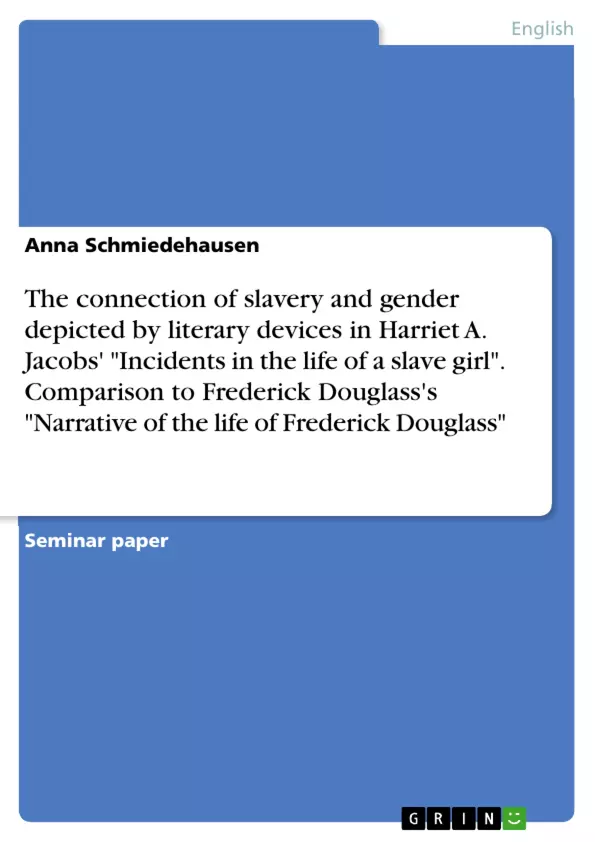The paper analyzes the connection of slavery and gender depicted by literary devices in Harriet A. Jacobs’ "Incidents in the life of a slave girl" compared to Frederick Douglass’s "Narrative of the life of Frederick Douglass". This paper is going to examine a few examples of the language and literary devices in these narratives and how they function.
In the first section of the paper the focus is on the literary depiction of slavery and gender in "Incidents in the life of a slave girl". In the second part the portrayal of these two characteristics is examined in "Narrative in the life of Frederick Douglass". In the third chapter, the attributes already mentioned are compared to each other. Finally, a conclusion follows. The literature used contains these two slave narratives by Jacobs and Douglass, as well as other writings about these narratives, literary stylistic devices, and the slave topic in general.
The year 1773 was essential to the beginning of African American literature in general and also for the genre of slave narratives. By publishing her first book of poetry and being the first female black writer, Phillis Wheatley paved the way for the development of black literature. As part of this development, the genre of slave narratives emerged as well. Slave narratives are written stories of African American slaves and their personal experiences and sufferings during their time of enslavement.
Their escape into freedom was often a turning point in the story. The author of these stories wrote them to depict the dehumanising and degrading effects of slavery. Furthermore, slave narratives were written especially for a white audience, since the narrators wanted to obtain that readers believed in the horrors they had to endure and to show the importance of abolishing the institution of slavery. To achieve that the narrators often used a very distinctive and vivid language in their narratives to support the imagination of their readers.
Inhaltsverzeichnis (Table of Contents)
- Introduction
- Literary Devices in 'Incidents in the life of a slave girl; written by herself' and 'Narrative of the life of Frederick Douglass, an American slave, written by himself'
- 'Incidents in the life of a slave girl'
- 'Narrative of the life of Frederick Douglass'
- Comparison Jacobs and Douglass
- Conclusion
Zielsetzung und Themenschwerpunkte (Objectives and Key Themes)
This paper aims to analyze the connection of slavery and gender depicted through literary devices in two seminal slave narratives, Harriet A. Jacobs' "Incidents in the life of a slave girl" and Frederick Douglass's "Narrative of the life of Frederick Douglass." It examines the use of vivid imagery, symbolism, and language to portray the dehumanizing effects of slavery on both men and women.
- The portrayal of slavery's brutality and impact on both men and women
- The use of literary devices to evoke empathy and understanding for the enslaved
- The exploration of gendered experiences within the context of slavery
- The role of narrative in shaping perceptions of slavery and its abolition
- The power of language to expose the injustices and realities of slavery
Zusammenfassung der Kapitel (Chapter Summaries)
- Introduction: The introduction provides an overview of African American literature, specifically the genre of slave narratives, and its emergence in the 18th century. It highlights the significance of Phillis Wheatley's work and the purpose of slave narratives to expose the horrors of slavery and advocate for its abolition. The introduction also introduces Harriet A. Jacobs and Frederick Douglass's narratives as key examples, outlining the paper's thesis and structure.
- 'Incidents in the life of a slave girl': This chapter examines the literary devices employed by Harriet A. Jacobs in her narrative, focusing on the cover and title, the portrayal of Linda's precocious maturity, and the vivid imagery used to depict the brutality of slavery.
- 'Narrative of the life of Frederick Douglass': This chapter delves into the literary strategies employed by Frederick Douglass in his narrative, focusing on his use of vivid imagery, symbolism, and powerful language to convey the experience of enslavement. It highlights Douglass's ability to create a compelling and impactful narrative that challenges the reader's perceptions.
Schlüsselwörter (Keywords)
The paper examines the themes of slavery, gender, literary devices, slave narratives, Harriet A. Jacobs, Frederick Douglass, "Incidents in the life of a slave girl," "Narrative of the life of Frederick Douglass," imagery, symbolism, and language.
- Quote paper
- Anna Schmiedehausen (Author), 2023, The connection of slavery and gender depicted by literary devices in Harriet A. Jacobs' "Incidents in the life of a slave girl". Comparison to Frederick Douglass's "Narrative of the life of Frederick Douglass", Munich, GRIN Verlag, https://www.hausarbeiten.de/document/1478863


